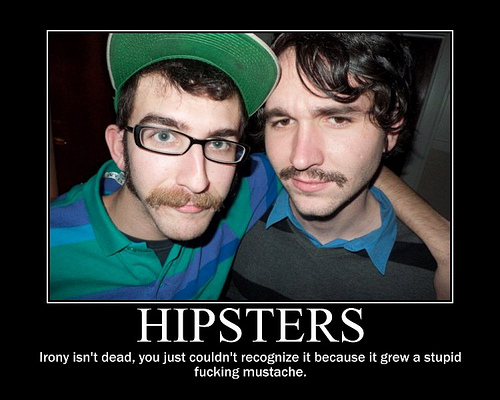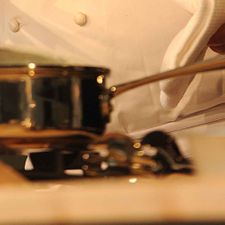Dead End CC by Steve Kennedy on Flickr
Accessibility is a Dead End
For decades now, classical music proponents have tried to make their organizations more accessible in order to attract audiences. This has always been a misguided and ineffective technique, and in fact I think it’s part of the reason we’ve seen shrinking interest in classical music even as other “high art” forms gain status and popularity.
The failure of classical music versus other art forms really hit home for me recently when I read this article: a young, cultured non-musician goes to hear an orchestral premiere of a composer he knows in another context and grapples to try to understand the music. He feels he “should” get it, but his lack of experience with classical music prevents him from enjoying the performance. If making music accessible were relevant this wouldn’t have happened: he would have had enough exposure to the standard canon to at least form an opinion on what he heard, whether positive or negative. Instead, he had no idea where to start and wrote an article about his frustrations.
For most people, classical music is more foreign than ever, and the focus on accessibility has siphoned attention away from audience-building techniques that actually work. I’m heartened to see more progressive classical groups experimenting with other models, but we need to completely reject accessibility as a concept in order to really see results.
The rise and fall of classical music (in 200 words or less)
Classical music is a retronym: prior to the 20th century the Western world only recognized “music” and “folk music”. The current name arose from the technology-fueled increase in cultural plurality that led to the creation of pop music. So while early 20th-century composers were busy expanding the limits of late 19th-century culture, new forms were slowly taking that culture’s place. The Cold War made this process less visible, because modernist music was useful for political reasons (aside from its artistic value) and received tremendous state support throughout the Western world. As that political need began to fade, however, funding dried up and classical music organizations were forced to pay attention to audiences. Clearly the organizations still believed in classical music and wanted to share it with as many people as possible, but cultural priorities had shifted away from the genre. In order to regain audience attention, presenters fell upon the idea of accessibility, which has two goals: (1) prevent current subscribers from leaving, and (2) lower the barriers to entry so that greater numbers of non-subscribers are willing to take a chance on your concerts.
[Edit 1 Jul 2013: To clarify, this is the definition of accessibility that I’m using here: Making programming or presentation choices that you consider inferior for the sake of drawing in the audience and/or employing an unfocused programming rationale like “it’s for everyone” or “anyone can enjoy it” to avoid the question of who you are making music for.]
The importance of connoisseurship
The main fallacy in this strategy is the assumption that people are more likely to attend if the experience is less challenging. We can look at virtually any area of human activity to see that easier doesn’t equal greater investment—and especially not when the space is crowded with competition. There are countless examples both in and outside of the arts that back up the idea that people don’t really care about something unless they’ve got some skin in the game.
Consider baseball. I don’t particularly understand this myself, but I know there are many many people who are fascinated with the statistics of the game (batting averages, runs, strikeouts, other metrics of player performance) and historical trivia (who hit which run in what game, who won which World Series, which team was the most successful at X or Y, etc). None of this is easy to learn. It takes hours of study on the part of the baseball fan, accompanied by financial investment in things like memorabilia, books, software, tickets to games, and cable TV packages.
If you took this element out of baseball, do you think the sport would have the same loyal following? Of course not. Half the pleasure of baseball (for dedicated fans) is being able to discuss all of these minutiae with their friends. It’s part of the social ritual of the sport, the shared bonds that make people feel part of a community. It fuels both cooperative and competitive attitudes, and it helps to build a hierarchy between people who might just sort of like baseball versus the “real” fans. The fact that it’s hard to learn all this stuff is crucial to its function as a ritual: nobody sits around discussing the beauty of basic multiplication tables (at least not past the age of 7) because it’s too simple and everyone shares this knowledge. The lack of ubiquity is what makes baseball trivia valuable.
We can extend this argument to any number of activities: stamp collecting, playing video games, wine collecting (or just connoisseurship without the collection), the “shop talk” of virtually every profession, growing orchids, buying vinyl records instead of digital downloads, golfing, baking bread, learning opus numbers, you name it.
Note that I used examples of this HAPPENING IN MUSIC. Connoisseurship is an important part of our art. I have a friend who loves dance music and has thousands of albums, categorized into seven-year increments starting at the disco era and moving forward. Why those divisions? Because he determined through listening that there was a significant shift in the dominant style of dance music every seven years, and the fact that he discovered that pattern vastly expands his enjoyment of the hobby.
Old-fashionedness and stereotypes
So maybe classical music is just too old-fashioned, too much associated with older generations? I don’t think this is true—not anymore anyway. Tastes go in waves, and people rediscover older trends once the negative associations of former generations have disappeared (cases in point: baroque music in the 19th century, hipster moustaches today).

CC craigfinlay on Flickr
In previous decades, I would have agreed that classical music’s associations with the establishment and its reputation as “your parents’/grandparents’ music” marred its prospects. But today’s seniors were coming of age with the Beatles, CCR, James Brown, and the Grateful Dead. THAT is what “old people’s music” sounds like today. I know lots of intelligent, young non-musicians who are curious about classical music, and when it is presented appropriately (more on that later), they want to learn more. They see the connoisseurship angle; they like that it’s a cultured experience with depth to explore. So I see no inherent reason why the genre can’t experience a resurgence in interest if presented properly.
To date, accessibility has simply reduced the mindspace for classical music so that most people’s only experience of it is in movies. In turn, people naturally associate film clichés to everything they hear in the concert hall, should they happen to go to a concert. You can chalk this reaction up to a lack of musical education if you like, but that’s just shifting the blame. Plato was essentially right that the vast majority of people associate certain types of music with certain activities or moods: you have workout music, driving-to-work music, music for getting things done late at night, music for cooking, elevator music, music for dancing, music for reading, music for films. We have taught people what classical music is for, it’s just not the meaning we wanted them to have.
The pigeonholing of classical music as a background to film gives us the ubiquitous “it sounds like a horror movie” reaction to modern pieces. These listeners’ reactions are not inappropriate: it does sound like a horror movie, in the same way that bulgogi or pad thai might taste “Chinese” to someone with a limited experience of Asian cuisine. If we want people to go beyond these basics, we need to invite them to invest energy into unravelling musical complexity, not pour MSG into the sauce. It doesn’t require a university music degree to understand classical music, but as with any cultural activity it does require some effort. Let’s not pretend otherwise, it just makes people suspicious.
The accessible competition
Of course, not everyone wants to be challenged all the time, and we all enjoy mindless, relaxing entertainment—classical music just isn’t a very good fit for this type of activity. “Classical” classical music requires us to have a feel for the musical culture of other centuries, and that doesn’t come without immersion or study. Few of us have a sense of the culinary styles of previous times—why should it be any easier with music? (e.g. Timbales were all the rage around 1900; basically overcooked spaghetti mashed into a round and baked.) Modern classical music presents a similar set of challenges, though this time the cultural climate to be learned is that of the Cold War musical intelligentsia or the artists that reacted against it. In both cases, effort also needs to be expended to get beyond the movie music associations.
Even the “easier” repertoire sounds alien today: you can do a concert of Haydn or a concert of Lachenmann, but either way you’ll have about the same chance of attracting someone with no preexisting ties to classical music. For all the contortions that music organizations go through to be accessible, at best they are slowing the ebb of subscriber atrophy and at worst they’re boring their subscribers and forcing them to look for something new to spend their time on. That’s a model doomed to fail. Eventually any subscriber base ages: every organization needs to find ways to draw in younger members or face extinction.
So what are the winning “accessible” pastimes? TV for one. If I just want to relax, why would I go across town to hear Palestrina or Mozart or Ives or a premiere by a local composer? I’ve got a TV, I know the culture of TV already, and I can enjoy the shows I like without putting in too much study or effort. If I want to have dinner while I watch, or stop watching early, or involve my friends in the watching, I can do all those things pretty easily and inexpensively. Classical music just can’t compete with that. Even the lightest of the classics has nothing on the Bachelorette or Dancing With The Stars.
Practical implications
What does this mean for classical music presenters? Obviously, the answer is not simply to program the hardest music you can and watch the tickets sell themselves. But accessibility is a dead end and presenters need to get more creative. A few ideas:
- Appeal to connoisseurship: People like festivals and themed programs. If they buy the idea that you’re presenting masterworks that everyone “should” know, or that you’re reviving an underappreciated oeuvre, or that you’re otherwise doing something important with your programming, they will be more invested in learning about it.
- Employ tiered access: Have donors-only or VIP events, backstage passes, or other exclusive elements that people will want to compete for. Don’t overadvertise these elements—get the information out with as much word of mouth as possible. You want people to feel that they’re in the know, not that they’re responding to a radio ad.
- Provide educational resources: Help people to get into material they don’t understand, but avoid solutions that look like edutainment or marketing gimmicks. Pre-concert talks, radio interviews, companion events, podcasts, collections of recordings or listening lists, study guides—all of these are viable ideas. The right selection will depend on the audience, but you want them to feel that they will enjoy the performance more if they put some effort in, then point them in the right direction so they know where to start.
- Get the word out the right way: You need to cut through the noise to get to your target audience, and you need to reach them in a way that they see as authentic. Advertising in the wrong place can be worse than not advertising, because it makes you look out of touch or desperate. If your audience is not using Facebook much, don’t try to force them to check out your quirky Facebook posts. On the other hand, if your audience is into watching YouTube videos, make a few interesting videos (or curate a collection) to draw attention to your event. Or maybe what you really need is to forget about the high-tech stuff and go for old-school direct mail and print ads. There’s no single right answer.
- Don’t go casual: Casual was risqué 20 years ago. Now, everything is casual by default. You’ll draw more investment if you insist on a dress code. Even stadium rock shows have dress codes—probably not the same as yours, and certainly they are unwritten, but dress codes nonetheless. Be a little snobby and make people feel that how they present themselves matters.
- Forget teleology: People don’t know the classical canon, and Mozart is not a gateway drug to Stockhausen. Look across genres for clues as to what will help people connect with a particular composer or stylistic period. You may have more success pairing elements of popular culture with classical music, or looking at connections through other art forms (e.g. minimalist music with minimalist art). In all cases, don’t assume your audience will get the connection just because you think it is plausible. Find connections that are broadly intuitive and appealing, test the concepts on people, then broadcast the theme as clearly and loudly as possible.
- Program for communities: Mainstream marketers have long since figured out that you have more success if you segment people into very specific buckets, things like “urban couple, 25-32, middle class, no children, renters, no car, buy organic food”. You have a mental image of who that is, right? Obviously most arts organizations don’t have the budget for such specific targeting, but it still pays to closely examine who in fact you are making music for. The more clearly you can define that community, the easier it is to find ways to access it. You also prevent yourself from trying to please everyone, or from spending energy on things you thought you should be doing but never questioned why.
- Pay attention to context: How and where you present your music is just as important as what you present. For instance, some classical ensembles have experimented with nightclub performances, which is fine in and of itself, but it doesn’t solve any problems. People go to nightclubs to dance to loud, rhythmic music without much dynamic contrast. If you can provide that, a nightclub is a good venue for you. If you can’t, you’ll just get boredom or indifference from the people there. Each performance space has a specific context, and working with that instead of against it will help win over your audience. You can push the boundaries of convention (e.g. I’ve long thought drinks (without ice) should be allowed in concerts) and/or do unusual things before and after the performance, but remember the function your default venue was designed to fulfill. There’s a good reason we have such thing as a concert hall—why not use it to its full potential?



